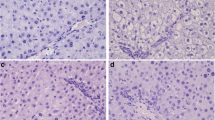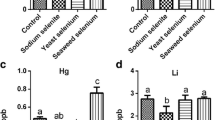Abstract
The purpose of this work was to measure the amounts of selected mineral elements (sodium, calcium, iron, selenium, magnesium, zinc, copper, and manganese) in the liver of Wistar rats and evaluate possible correlations between the levels of these minerals and the lipid metabolism in the studied animals. Three experimental groups each containing six Wistar rats were designed. Each group was fed a different diet. The control group was fed a diet prepared with fresh soybean oil and named control group—CG. The second group (named experimental group B—EGB) and third group (named experimental group C—EGC) were fed a diet containing soybean oil that had been used to fry different foods for four or ten cycles, respectively. The mineral elements in Wistar rat livers were measured by inductively coupled plasma optical emission spectrometry (ICP OES). Only the elements calcium and selenium differed significantly between the control and experimental groups. There was a significant reduction of 33 % for Ca and 41 % for Se in the EGB in comparison to the control group. The reduction in mineral concentration, especially Se, is the result of interactions with fatty acid metabolism. The animals in the EGC exhibited more intracytoplasmic accumulation of fat and more intense vasodilatation, in relation to the other groups. Collectively, evidence hereby collected suggests that impaired dietary lipid quality in otherwise balanced diets can reduce hepatic Se levels and potentially harm liver function.



Similar content being viewed by others
References
Henriques GS, Bedeschi LB, Mazzetti CMS, Cozzolino SMF (2012) Biomarcadores para micronutrientes. In: Cozzolino SMF (ed) Biodisponibilidade de Nutrientes. Manole, Baueri
Michael IG, Harwood JL, Frayn KN (2002) Lipid biochemistry, 5th edn. Blackwell Science Ltd, a Blackwell Publishing Company, United Kingdom
Kim J, Choi S, Lee H, Hwang I, Lee Y, An B, Lee S, Kim H, Kang B, Hwang D (2012) Selenium significantly inhibits adipocyte hypertrophy and abdominal fat accumulation in OLETF rats via induction of fatty acid β-oxidation. Biol Trace Elem Res 150(1-3):360–370
Rayman MP (2009) Selenoproteins and human health: insights from epidemiological data. Biochim Biophys Acta Gen Subj 1790(11):1533–1540
Selenius M, Rundlof AK, Olm E, Fernandes AP, Bjornstedt M (2010) Selenium and the selenoprotein thioredoxin reductase in the prevention, treatment and diagnostics of cancer. Antioxid Redox Signal 12(7):867–880
Stranges S, Marshall JR, Natarajan R, Donahue RP, Trevisan M, Combs GF, Cappuccio FP, Ceriello A, Reid ME (2007) Effects of long-term selenium supplementation on the incidence of type 2 diabetes - a randomized trial. Ann Intern Med 147(4):217–223
Czernichow S, Vergnaud AC, Galan P, Arnaud J, Favier A, Faure H, Huxley R, Hercberg S, Ahluwalia N (2009) Effects of long-term antioxidant supplementation and association of serum antioxidant concentrations with risk of metabolic syndrome in adults. Am J Clin Nutr 90(2):329–335. doi:10.3945/ajcn.2009.27635
Fairweather-Tait SJ (1997) Bioavailability of selenium. Eur J Clin Nutr 244(1):S20–S23
Burenjargal M, Totani N (2009) Cytotoxic compounds generated in heated oil and assimilation of oil in Wistar rats. J Oleo Sci 58:1–7
Choe E, Min DB (2007) Chemistry of deep-fat frying oils. J Food Sci 72:77–86
Farhoosh R, Moosavi SMR (2008) Carbonyl value in monitoring of the quality of used frying oils. Anal Chim Acta 617:18–21
Lamboni C, Sébédio J-L, Perkins EG (1998) Cyclic fatty acid monomers from dietary heated fats affect rat liver enzyme activity. Lipids 33:675–681
Cortez-Pinto H, Moura MC, Day CP (2006) Non-alcoholic steatohepatitis: from cell biology to clinical practice. J Hepatol 44:197–208
Wang D, Wei Y, Schmoll D, Maclean KN, Pagliassotti MJ (2006) Endoplasmic reticulum stress increases glucose-6-phosphatase and glucose cycling in liver cells. Endocrinology 147:350–358
Gentile CL, Frye MA, Pagliassotti MJ (2012) Fatty acids and the endoplasmic reticulum in non-alcoholic fatty liver disease. Biofactors 37(1):8–16. doi:10.1002/biof.135
Mattson FH, Grundy SM (1985) Comparison of effects of dietary saturated, monounsaturated, and polyunsaturated fatty acids on plasma lipids and lipoproteins in man. J Lipid Res 26:194–202
Grundy SM (2007) Metabolic syndrome: a multiplex cardiovascular risk factor. J Clin Endocrinol Metab 92(2):399–404
Reeves PG, Nielsen FH, Fahey GC Jr (1993) AIN-93 purified diets for laboratory rodents; final report of the American Institute of Nutrition ad hoc writing committee and the reformulation of the AIN-76 rodent diet. J Nutr 123(11):1939–1951
Bourre JM, Francois M, Youyou A, Dumont O, Piciotti M, Pascal G, Durand G (1989) The effect of dietary a-linolenic acid on the composition of nerve membranes, enzymatic activity, amplitude of electrophysiological parameters, resistance to poisons and performance of learning tasks in rats. J Nutr 119:1880–1892
Research IfLA (2011) Guide for the Care and use of laboratory animals. Eighth Edition edn. Committee for the Update of the Guide for the Care and Use of Laboratory Animals. The National Academies Press, Washington, D.C
Silva H (2009) Complexos de Platina com Diaminas N-alquiladas de Cadeia Longa: Síntese, Inclusão em Lipossomas, Atividade Citotóxica, Antitumoral e Estudos Farmacocinéticos. doutorado. Universidade Federal de Juiz de Fora, Juiz de Fora
Thomson CD (2006) Selenium: Its role in health and disease. Asia Pac J Clin Nutr 15(3):25–30
Sanmartin C, Plano D, Font M, Palop JA (2011) Selenium and clinical trials: new therapeutic evidence for multiple diseases. Curr Med Chem 18(30):4635–4650
Volp ACP, Bressan J, Hermsdorff HHM, Zulet MÁ, Martinez JA (2010) Selenium antioxidant effects and its link with inflammation and metabolic syndrome. Rev Nutr 23(4):581–590
Legrain Y, Touat-Hamici Z, Chavatte L (2014) Interplay between selenium levels, selenoprotein expression and replicative senescence in WI-38 human fibroblasts. J Biol Chem 289:6299–6310
Barra PMC, Oliveira PL, Aragão DMO, Sabarense CM, Aarestrup BJV, Azevedo MS, Costa ACO, Micke GA, Oliveira MAL (2014) Study of fatty acids profile in Wistar rats liver by capillary zone electrophoresis associate to chemometric approach. J Braz Chem Soc 25(4):675–685
Acknowledgments
The authors wish to acknowledge the Conselho Nacional de Desenvolvimento Científico e Tecnológico (CNPq, 475055/2011-0 and 301689/2011-3), the Fundação de Amparo à Pesquisa do Estado de Minas Gerais of Brazil (FAPEMIG-CEX-PPM 00398-13 and CEX-RED-0010-14 from Rede Mineira de Química), the Coordenação de Aperfeiçoamento de Pessoal de Nível Superior (CAPES) for fellowships and financial support and the Center for Reproductive Biology—UFJF.
Author information
Authors and Affiliations
Corresponding author
Rights and permissions
About this article
Cite this article
de Castro Barra, P.M., Sabarense, C.M., Alvarenga, M.B. et al. Selenium Content in the Liver of Wistar Rats Fed Diets of Different Fatty Acid Quality. Biol Trace Elem Res 168, 441–446 (2015). https://doi.org/10.1007/s12011-015-0359-7
Received:
Accepted:
Published:
Issue Date:
DOI: https://doi.org/10.1007/s12011-015-0359-7




